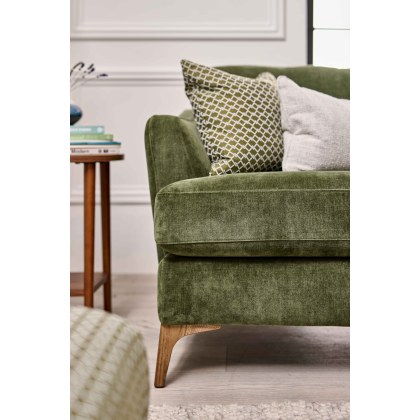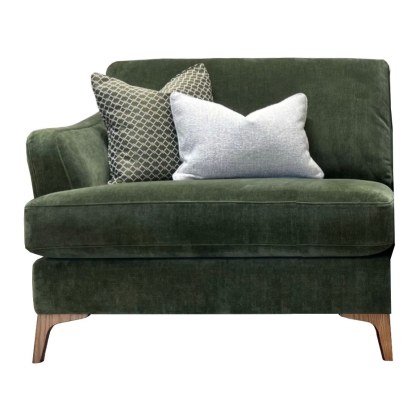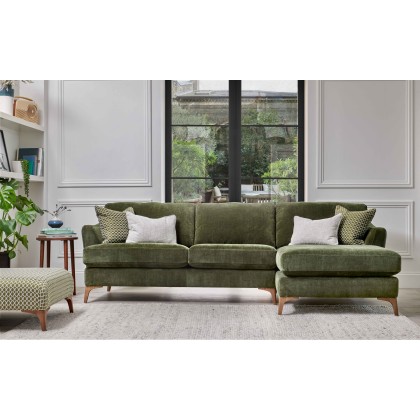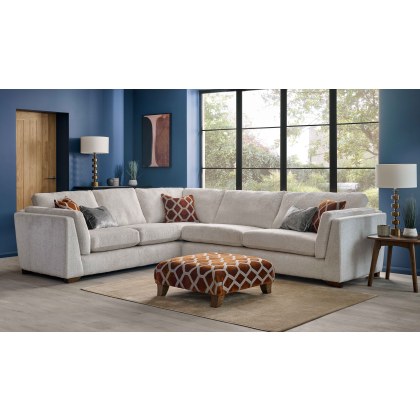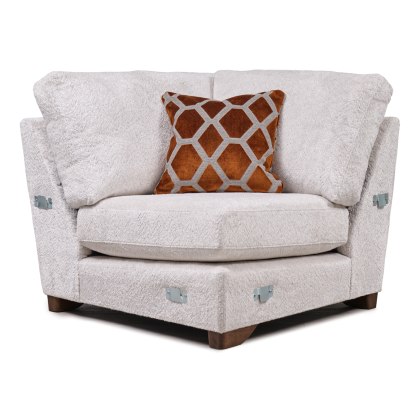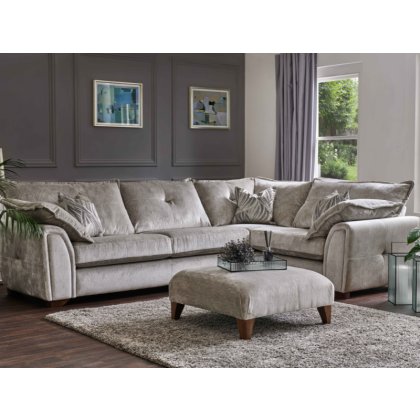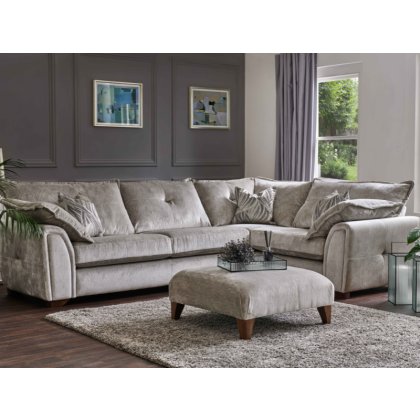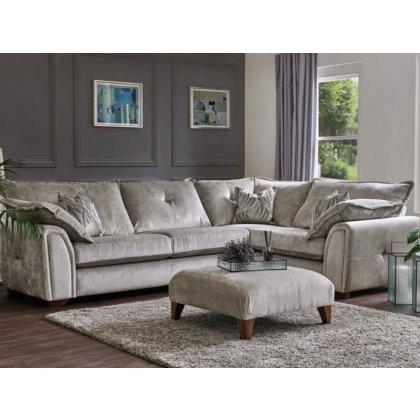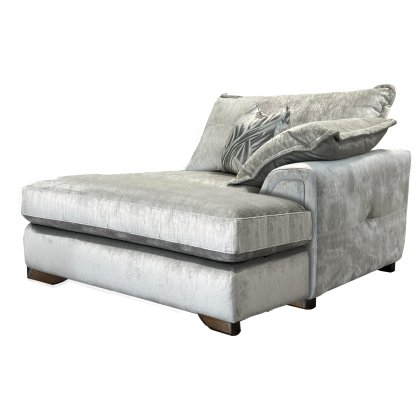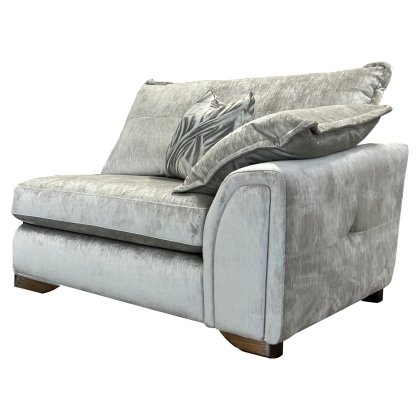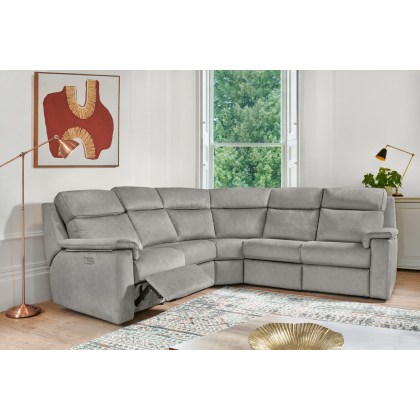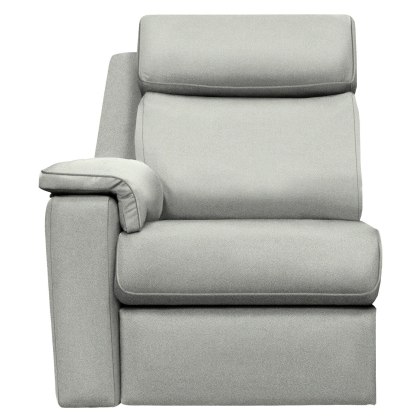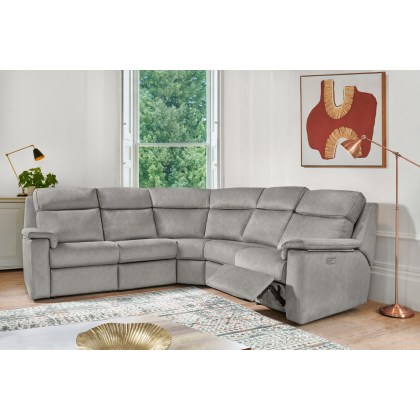Modular Corner Sofas
Ashwood Hansson 2 Seater Left-Hand Facing End Unit
The Ashwood Hansson is a modern range with a sophisticated style sure to enhance any home, offering a choice of pieces to make up a corner sofa to the dimensions you require. This 2 Seater Left-Hand Facing End Unit is available in a variety of fabrics, including an Aquaclean collection and includes one feather filled scatter cushion and one feather filled bolster cushion.
Was £1185 Now £1007
Ashwood Hansson 2 Seater Right-Hand Facing End Unit
The Ashwood Hansson is a modern range with a sophisticated style sure to enhance any home, offering a choice of pieces to make up a corner sofa to the dimensions you require. This 2 Seater Right-Hand Facing End Unit is available in a variety of fabrics, including an Aquaclean collection and includes one feather filled scatter cushion and one feather filled bolster cushion.
£1185
Ashwood Hansson 2.5 Seater Left-Hand Facing End Unit
The Ashwood Hansson is a modern range with a sophisticated style sure to enhance any home, offering a choice of pieces to make up a corner sofa to the dimensions you require. This 2.5 Seater Left-Hand Facing Unit is available in a variety of fabrics, including an Aquaclean collection and includes one feather filled scatter cushion and one feather filled bolster cushion.
Was £1199 Now £1019
Ashwood Hansson 2.5 Seater Right-Hand Facing End Unit
The Ashwood Hansson is a modern range with a sophisticated style sure to enhance any home, offering a choice of pieces to make up a corner sofa to the dimensions you require. This 2.5 Seater Right-Hand Facing Unit is available in a variety of fabrics, including an Aquaclean collection and includes one feather filled scatter cushion and one feather filled bolster cushion.
Was £1199 Now £1019
Ashwood Hansson 3 Seater Left-Hand Facing End Unit
The Ashwood Hansson is a modern range with a sophisticated style sure to enhance any home, offering a choice of pieces to make up a corner sofa to the dimensions you require. This 3 Seater Left-Hand Facing Unit is available in a variety of fabrics, including an Aquaclean collection and includes one feather filled scatter cushion and one feather filled bolster cushion.
Was £1355 Now £1151
Ashwood Hansson 3 Seater Right-Hand Facing End Unit
The Ashwood Hansson is a modern range with a sophisticated style sure to enhance any home, offering a choice of pieces to make up a corner sofa to the dimensions you require. This Left-Hand Facing Cuddler Unit is available in a variety of fabrics, including an Aquaclean collection and includes one feather filled scatter cushion and one feather filled bolster cushion.
Was £1355 Now £1151
Ashwood Hansson Corner Unit
The Ashwood Hansson is a modern range with a sophisticated style sure to enhance any home, offering a choice of pieces to make up a corner sofa to the dimensions you require. This Corner Unit is available in a variety of fabrics, including an Aquaclean collection and includes two feather filled scatter cushions.
Was £799 Now £679
Ashwood Hansson Cuddler Left-Hand Facing End Unit
The Ashwood Hansson is a modern range with a sophisticated style sure to enhance any home, offering a choice of pieces to make up a corner sofa to the dimensions you require. This Left-Hand Facing Cuddler Unit is available in a variety of fabrics, including an Aquaclean collection and includes one feather filled scatter cushion and one feather filled bolster cushion.
Was £989 Now £840
Ashwood Hansson Cuddler Right-Hand Facing End Unit
The Ashwood Hansson is a modern range with a sophisticated style sure to enhance any home, offering a choice of pieces to make up a corner sofa to the dimensions you require. This Right-Hand Facing Cuddler Unit is available in a variety of fabrics, including an Aquaclean collection and includes one feather filled scatter cushion and one feather filled bolster cushion.
Was £989 Now £840
Ashwood Hansson Left-Hand Facing Chaise End
The Ashwood Hansson is a modern range with a sophisticated style sure to enhance any home, offering a choice of pieces to make up a corner sofa to the dimensions you require. This Right-Hand Facing Chaise Unit is available in a variety of fabrics, including an Aquaclean collection and includes one feather filled scatter cushion and one feather filled bolster cushion.
£935
Ashwood Hansson Right-Hand Facing Chaise End
The Ashwood Hansson is a modern range with a sophisticated style sure to enhance any home, offering a choice of pieces to make up a corner sofa to the dimensions you require. This Right-Hand Facing Chaise Unit is available in a variety of fabrics, including an Aquaclean collection and includes one feather filled scatter cushion and one feather filled bolster cushion.
Was £935 Now £794
Ashwood Maxwell 2 Seater Sofa End Unit
With it's clean lines, the Ashwood Maxwell collection has a stylish, contemporary feel, offering a choice of pieces to make up a corner sofa to the dimensions you require. This 2 Seater End Unit is available in a variety of fabrics, including an Aquaclean collection and includes one feather filled scatter cushion and one bolster cushion.
Was £1309 Now £1112
Ashwood Maxwell 4 Seater Sofa End Unit
With it's clean lines, the Ashwood Maxwell collection has a stylish, contemporary feel, offering a choice of pieces to make up a corner sofa to the dimensions you require. This 4 Seater End Unit is available in a variety of fabrics, including an Aquaclean collection and includes one feather filled scatter cushion and one bolster cushion.
Was £1485 Now £1262
Ashwood Maxwell Armless Unit
With it's clean lines, the Ashwood Maxwell collection has a stylish, contemporary feel, offering a choice of pieces to make up a corner sofa to the dimensions you require. This Armless Unit is available in a variety of fabrics, including an Aquaclean collection and includes one feather filled scatter cushion.
Was £765 Now £650
Ashwood Maxwell Corner Unit
With it's clean lines, the Ashwood Maxwell collection has a stylish, contemporary feel, offering a choice of pieces to make up a corner sofa to the dimensions you require. This Corner Unit is available in a variety of fabrics, including an Aquaclean collection and includes one feather filled scatter cushion.
Was £829 Now £704
Ashwood Maxwell Cuddler End Unit
With it's clean lines, the Ashwood Maxwell collection has a stylish, contemporary feel, offering a choice of pieces to make up a corner sofa to the dimensions you require. This Cuddler End Unit is available in a variety of fabrics, including an Aquaclean collection and includes one feather filled scatter cushion and one bolster cushion.
Was £889 Now £755
Ashwood Toulouse 2 Seater Left-Hand Facing End Unit
The Ashwood Toulouse brings timeless sophistication to you home with its elegant curves, deep cushioning and refined detailing. The range offers a choice of pieces to make up a corner sofa to the dimensions you require. This 2 Seater Left-Hand Facing End Unit is available in a variety of fabrics, including an Aquaclean collection and includes one feather filled scatter cushion.
Was £1185 Now £1007
Ashwood Toulouse 2 Seater Right-Hand Facing End Unit
The Ashwood Toulouse brings timeless sophistication to you home with its elegant curves, deep cushioning and refined detailing. The range offers a choice of pieces to make up a corner sofa to the dimensions you require. This 2 Seater Right-Hand Facing End Unit is available in a variety of fabrics, including an Aquaclean collection and includes one feather filled scatter cushion.
Was £1185 Now £1007
Ashwood Toulouse 3 Seater Left-Hand Facing End Unit
The Ashwood Toulouse brings timeless sophistication to you home with its elegant curves, deep cushioning and refined detailing. The range offers a choice of pieces to make up a corner sofa to the dimensions you require. This 3 Seater Left-Hand Facing End Unit is available in a variety of fabrics, including an Aquaclean collection and includes one feather filled scatter cushion.
Was £1379 Now £1172
Ashwood Toulouse 3 Seater Right-Hand Facing End Unit
The Ashwood Toulouse brings timeless sophistication to you home with its elegant curves, deep cushioning and refined detailing. The range offers a choice of pieces to make up a corner sofa to the dimensions you require. This 3 Seater Right-Hand Facing End Unit is available in a variety of fabrics, including an Aquaclean collection and includes one feather filled scatter cushion.
Was £1379 Now £1172
Ashwood Toulouse Armless Unit
The Ashwood Toulouse brings timeless sophistication to you home with its elegant curves, deep cushioning and refined detailing. The range offers a choice of pieces to make up a corner sofa to the dimensions you require. This Armless Unit is available in a variety of fabrics, including an Aquaclean collection.
Was £719 Now £611
Ashwood Toulouse Corner Unit
The Ashwood Toulouse brings timeless sophistication to you home with its elegant curves, deep cushioning and refined detailing. The range offers a choice of pieces to make up a corner sofa to the dimensions you require. This Corner Unit is available in a variety of fabrics, including an Aquaclean collection and includes one feather filled scatter cushion.
Was £779 Now £662
Ashwood Toulouse Left-Hand Facing Chaise End Unit
The Ashwood Toulouse brings timeless sophistication to you home with its elegant curves, deep cushioning and refined detailing. The range offers a choice of pieces to make up a corner sofa to the dimensions you require. This Left-Hand Facing Chaise End Unit is available in a variety of fabrics, including an Aquaclean collection and includes one feather filled scatter cushion.
Was £979 Now £832
Ashwood Toulouse Left-Hand Facing Cuddler End Unit
The Ashwood Toulouse brings timeless sophistication to you home with its elegant curves, deep cushioning and refined detailing. The range offers a choice of pieces to make up a corner sofa to the dimensions you require. This Left-Hand Facing Cuddler End Unit is available in a variety of fabrics, including an Aquaclean collection and includes one feather filled scatter cushion.
Was £979 Now £832
Ashwood Toulouse Right-Hand Facing Chaise End Unit
The Ashwood Toulouse brings timeless sophistication to you home with its elegant curves, deep cushioning and refined detailing. The range offers a choice of pieces to make up a corner sofa to the dimensions you require. This Right-Hand Facing Chaise End Unit is available in a variety of fabrics, including an Aquaclean collection and includes one feather filled scatter cushion.
Was £979 Now £832
Ashwood Toulouse Right-Hand Facing Cuddler End Unit
The Ashwood Toulouse brings timeless sophistication to you home with its elegant curves, deep cushioning and refined detailing. The range offers a choice of pieces to make up a corner sofa to the dimensions you require. This Right-Hand Facing Cuddler End Unit is available in a variety of fabrics, including an Aquaclean collection and includes one feather filled scatter cushion.
Was £979 Now £832
G Plan Ellis Fabric Armless Curved Unit
The G Plan Ellis range embodies a modern, timeless style with it's clean, crisp lines and distinctive back cushion detailing and is available in a variety of fabric choices, including G Plans Aquaclean collection. With modular options, you can build your perfect combination creating a bespoke sofa for your space.
from £581
G Plan Ellis Fabric Armless Unit
The G Plan Ellis range embodies a modern, timeless style with it's clean, crisp lines and distinctive back cushion detailing and is available in a variety of fabric choices, including G Plans Aquaclean collection. With modular options, you can build your perfect combination creating a bespoke sofa for your space.
from £581
G Plan Ellis Fabric Curved Corner Unit
The G Plan Ellis range embodies a modern, timeless style with it's clean, crisp lines and distinctive back cushion detailing and is available in a variety of fabric choices, including G Plans Aquaclean collection. With modular options, you can build your perfect combination creating a bespoke sofa for your space.
from £746
G Plan Ellis Fabric Small LHF Manual Recliner Unit
The G Plan Ellis range embodies a modern, timeless style with it's clean, crisp lines and distinctive back cushion detailing and is available in a variety of fabric choices, including G Plans Aquaclean collection. With modular options, you can build your perfect combination creating a bespoke sofa for your space.
from £1027
G Plan Ellis Fabric Small LHF Power Recliner Unit
The G Plan Ellis range embodies a modern, timeless style with it's clean, crisp lines and distinctive back cushion detailing and is available in a variety of fabric choices, including G Plans Aquaclean collection. With modular options, you can build your perfect combination creating a bespoke sofa for your space.
from £1027
G Plan Ellis Fabric Small LHF Power Recliner Unit with Headrest and Lumbar
The G Plan Ellis range embodies a modern, timeless style with it's clean, crisp lines and distinctive back cushion detailing and is available in a variety of fabric choices, including G Plans Aquaclean collection. With modular options, you can build your perfect combination creating a bespoke sofa for your space.
from £1134
G Plan Ellis Fabric Small LHF Unit
The G Plan Ellis range embodies a modern, timeless style with it's clean, crisp lines and distinctive back cushion detailing and is available in a variety of fabric choices, including G Plans Aquaclean collection. With modular options, you can build your perfect combination creating a bespoke sofa for your space.
from £746
G Plan Ellis Fabric Small RHF Manual Recliner Unit
The G Plan Ellis range embodies a modern, timeless style with it's clean, crisp lines and distinctive back cushion detailing and is available in a variety of fabric choices, including G Plans Aquaclean collection. With modular options, you can build your perfect combination creating a bespoke sofa for your space.
from £1027
G Plan Ellis Fabric Small RHF Power Recliner Unit
The G Plan Ellis range embodies a modern, timeless style with it's clean, crisp lines and distinctive back cushion detailing and is available in a variety of fabric choices, including G Plans Aquaclean collection. With modular options, you can build your perfect combination creating a bespoke sofa for your space.
from £1027
G Plan Ellis Fabric Small RHF Power Recliner Unit with Headrest and Lumbar
The G Plan Ellis range embodies a modern, timeless style with it's clean, crisp lines and distinctive back cushion detailing and is available in a variety of fabric choices, including G Plans Aquaclean collection. With modular options, you can build your perfect combination creating a bespoke sofa for your space.
from £1134
G Plan Ellis Fabric Small RHF Unit
The G Plan Ellis range embodies a modern, timeless style with it's clean, crisp lines and distinctive back cushion detailing and is available in a variety of fabric choices, including G Plans Aquaclean collection. With modular options, you can build your perfect combination creating a bespoke sofa for your space.
from £746
G Plan Ellis Leather Armless Curved Unit
The G Plan Ellis range embodies a modern, timeless style with it's clean, crisp lines and distinctive back cushion detailing and is available in a variety of premium leather choices. With modular options, you can build your perfect combination creating a bespoke sofa for your space.
from £776
G Plan Ellis Leather Armless Unit
The G Plan Ellis range embodies a modern, timeless style with it's clean, crisp lines and distinctive back cushion detailing and is available in a variety of premium leather choices. With modular options, you can build your perfect combination creating a bespoke sofa for your space.
from £776
G Plan Ellis Leather Curved Corner Unit
The G Plan Ellis range embodies a modern, timeless style with it's clean, crisp lines and distinctive back cushion detailing and is available in a variety of premium leather choices. With modular options, you can build your perfect combination creating a bespoke sofa for your space.
from £1027
G Plan Ellis Leather Small LHF Manual Recliner Unit
The G Plan Ellis range embodies a modern, timeless style with it's clean, crisp lines and distinctive back cushion detailing and is available in a variety of premium leather choices. With modular options, you can build your perfect combination creating a bespoke sofa for your space.
from £1383
G Plan Ellis Leather Small LHF Power Recliner Unit
The G Plan Ellis range embodies a modern, timeless style with it's clean, crisp lines and distinctive back cushion detailing and is available in a variety of premium leather choices. With modular options, you can build your perfect combination creating a bespoke sofa for your space.
from £1383
G Plan Ellis Leather Small LHF Power Recliner Unit with Headrest and Lumbar
The G Plan Ellis range embodies a modern, timeless style with it's clean, crisp lines and distinctive back cushion detailing and is available in a variety of premium leather choices. With modular options, you can build your perfect combination creating a bespoke sofa for your space.
from £1523
G Plan Ellis Leather Small LHF Unit
The G Plan Ellis range embodies a modern, timeless style with it's clean, crisp lines and distinctive back cushion detailing and is available in a variety of premium leather choices. With modular options, you can build your perfect combination creating a bespoke sofa for your space.
from £1027
G Plan Ellis Leather Small RHF Manual Recliner Unit
The G Plan Ellis range embodies a modern, timeless style with it's clean, crisp lines and distinctive back cushion detailing and is available in a variety of premium leather choices. With modular options, you can build your perfect combination creating a bespoke sofa for your space.
from £1383
G Plan Ellis Leather Small RHF Power Recliner Unit
The G Plan Ellis range embodies a modern, timeless style with it's clean, crisp lines and distinctive back cushion detailing and is available in a variety of premium leather choices. With modular options, you can build your perfect combination creating a bespoke sofa for your space.
from £1383
G Plan Ellis Leather Small RHF Power Recliner Unit with Headrest and Lumbar
The G Plan Ellis range embodies a modern, timeless style with it's clean, crisp lines and distinctive back cushion detailing and is available in a variety of premium leather choices. With modular options, you can build your perfect combination creating a bespoke sofa for your space.
from £1523
G Plan Ellis Leather Small RHF Unit
The G Plan Ellis range embodies a modern, timeless style with it's clean, crisp lines and distinctive back cushion detailing and is available in a variety of premium leather choices. With modular options, you can build your perfect combination creating a bespoke sofa for your space.
from £1027








